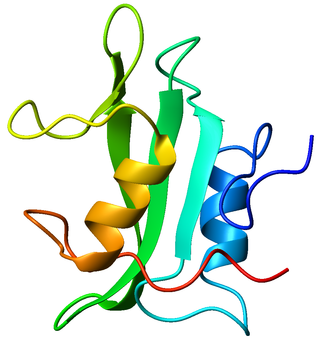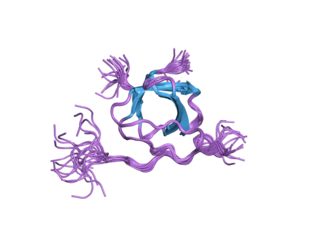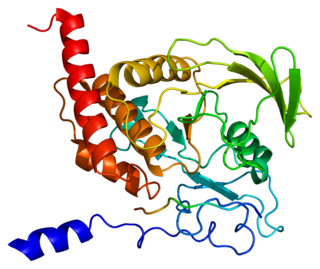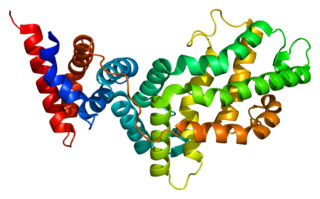Tyrosine-protein kinase HCK is an enzyme that in humans is encoded by the HCK gene. [5]
Tyrosine-protein kinase HCK is an enzyme that in humans is encoded by the HCK gene. [5]
HCK comprises five distinct domains which include two terminal domains and three SH domains. The N-terminal domain is important for lipid modifications and a C-terminal domain includes a regulatory tyrosine residue. Next, HCK comprises three highly conserved SH domains: SH1, SH2, and SH3. The catalytic SH1 domain houses the kinase's active site. The regulatory SH3 and SH2 domains are tightly bound together when HCK is in an inactive state. [6] [7] [8]
HCK is localized in the cytoplasm where it executes its functions as a kinase. In a steady state, HCK remains in an inactive conformation. Upon interaction with stimuli, such as TLR4 or IL-2 [9] [10] , C-terminal tyrosine residues of HCK are dephosphorylated by phosphatases, e.g. CD45, and the inactive conformation of HCK is disrupted resulting in HCK activation [11] . Activated HCK can then phosphorylate downstream molecules such as Bcr/Abl, PI3K/AKT, MAPK/ERK or STAT5 which then participate in myeloid cell polarization, proliferation and migration. [12] [13] [14] A case study of a patient with a loss of C-terminal tyrosine residue in HCK showed that the patient suffered from severe pneumonia and vasculitis. This was due to increased HCK activity which led to increased myeloid cell migration and effector functions, such as the production of pro-inflammatory cytokines IL1b, IL-6, IL-8, and TNF-a, and the production of reactive oxygen species. These abnormal functions manifested as the infiltration of inflammatory leukocytes into the lungs and skin, resulting in pneumonia and vasculitis. [15]
HCK plays a key role during inflammation as it participates in actin-dependent processes like phagocytosis, membrane remodeling, and cell migration. It has also been shown that HCK participates in NLRP3 inflammasome formation and LPS-induced inflammatory response in mice. However, the mechanism of action is yet to be elucidated. [16] HCK not only participates in inflammation-associated processes but also in cancerous processes. It has been shown, that HCK is part of a CXCL12/CXCR4 signaling axis that is partially responsible for the migration of leukemic cells in the bone marrow of patients with acute myeloid leukemia. This finding proposes HCK to be a novel target for the treatment of acute myeloid leukemia. [14] HCK and the Src family kinases have also been implicated in driving cell survival in drug-tolerant cancer cells. [17]
HCK has been shown to interact with:

A tyrosine kinase is an enzyme that can transfer a phosphate group from ATP to the tyrosine residues of specific proteins inside a cell. It functions as an "on" or "off" switch in many cellular functions.

The Philadelphia chromosome or Philadelphia translocation (Ph) is a specific genetic abnormality in chromosome 22 of leukemia cancer cells. This chromosome is defective and unusually short because of reciprocal translocation, t(9;22)(q34;q11), of genetic material between chromosome 9 and chromosome 22, and contains a fusion gene called BCR-ABL1. This gene is the ABL1 gene of chromosome 9 juxtaposed onto the breakpoint cluster region BCR gene of chromosome 22, coding for a hybrid protein: a tyrosine kinase signaling protein that is "always on", causing the cell to divide uncontrollably by interrupting the stability of the genome and impairing various signaling pathways governing the cell cycle.

Tyrosine-protein kinase ABL1 also known as ABL1 is a protein that, in humans, is encoded by the ABL1 gene located on chromosome 9. c-Abl is sometimes used to refer to the version of the gene found within the mammalian genome, while v-Abl refers to the viral gene, which was initially isolated from the Abelson murine leukemia virus.

Lck is a 56 kDa protein that is found inside specialized cells of the immune system called lymphocytes. The Lck is a member of Src kinase family (SFK) and is important for the activation of T-cell receptor (TCR) signaling in both naive T cells and effector T cells. The role of Lck is less prominent in the activation or in the maintenance of memory CD8 T cells in comparison to CD4 T cells. In addition, the constitutive activity of the mouse Lck homolog varies among memory T cell subsets. It seems that in mice, in the effector memory T cell (TEM) population, more than 50% of Lck is present in a constitutively active conformation, whereas less than 20% of Lck is present as active form in central memory T cells. These differences are due to differential regulation by SH2 domain–containing phosphatase-1 (Shp-1) and C-terminal Src kinase.

Growth factor receptor-bound protein 2, also known as Grb2, is an adaptor protein involved in signal transduction/cell communication. In humans, the GRB2 protein is encoded by the GRB2 gene.

The breakpoint cluster region protein (BCR) also known as renal carcinoma antigen NY-REN-26 is a protein that in humans is encoded by the BCR gene. BCR is one of the two genes in the BCR-ABL fusion protein, which is associated with the Philadelphia chromosome. Two transcript variants encoding different isoforms have been found for this gene.

Adapter molecule crk also known as proto-oncogene c-Crk is a protein that in humans is encoded by the CRK gene.

Tyrosine-protein kinase Lyn is a protein that in humans is encoded by the LYN gene.

Tyrosine-protein phosphatase non-receptor type 6, also known as Src homology region 2 domain-containing phosphatase-1 (SHP-1), is an enzyme that in humans is encoded by the PTPN6 gene.

Cbl is a mammalian gene family. CBL gene, a part of the Cbl family, encodes the protein CBL which is an E3 ubiquitin-protein ligase involved in cell signalling and protein ubiquitination. Mutations to this gene have been implicated in a number of human cancers, particularly acute myeloid leukaemia.

RAS p21 protein activator 1 or RasGAP, also known as RASA1, is a 120-kDa cytosolic human protein that provides two principal activities:

Crk-like protein is a protein that in humans is encoded by the CRKL gene.

Docking protein 1 is a protein that in humans is encoded by the DOK1 gene.

Rap guanine nucleotide exchange factor 1 is a protein that in humans is encoded by the RAPGEF1 gene.

Proto-oncogene tyrosine-protein kinase Src, also known as proto-oncogene c-Src, or simply c-Src, is a non-receptor tyrosine kinase protein that in humans is encoded by the SRC gene. It belongs to a family of Src family kinases and is similar to the v-Src gene of Rous sarcoma virus. It includes an SH2 domain, an SH3 domain and a tyrosine kinase domain. Two transcript variants encoding the same protein have been found for this gene.

Proto-oncogene vav is a protein that in humans is encoded by the VAV1 gene.

Src homology 2 (SH2) domain containing inositol polyphosphate 5-phosphatase 1(SHIP1) is an enzyme with phosphatase activity. SHIP1 is structured by multiple domain and is encoded by the INPP5D gene in humans. SHIP1 is expressed predominantly by hematopoietic cells but also, for example, by osteoblasts and endothelial cells. This phosphatase is important for the regulation of cellular activation. Not only catalytic but also adaptor activities of this protein are involved in this process. Its movement from the cytosol to the cytoplasmic membrane, where predominantly performs its function, is mediated by tyrosine phosphorylation of the intracellular chains of cell surface receptors that SHIP1 binds. Insufficient regulation of SHIP1 leads to different pathologies.

Tyrosine-protein kinase ABL2 also known as Abelson-related gene (Arg) is an enzyme that in humans is encoded by the ABL2 gene.

Ras GTPase-activating protein 3 is an enzyme that in humans is encoded by the RASA3 gene.
A non-receptor tyrosine kinase (nRTK) is a cytosolic enzyme that is responsible for catalysing the transfer of a phosphate group from a nucleoside triphosphate donor, such as ATP, to tyrosine residues in proteins. Non-receptor tyrosine kinases are a subgroup of protein family tyrosine kinases, enzymes that can transfer the phosphate group from ATP to a tyrosine residue of a protein (phosphorylation). These enzymes regulate many cellular functions by switching on or switching off other enzymes in a cell.